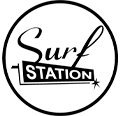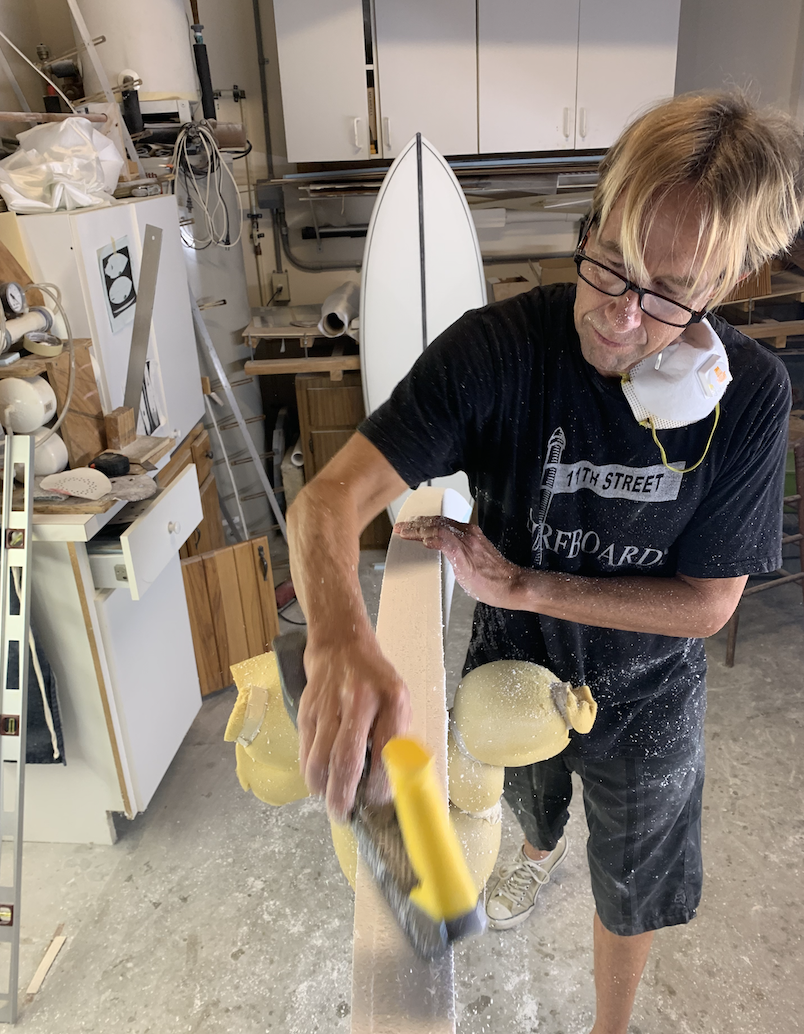When you think about a “backyard shaper”, what comes to mind? Uneven rails? A crooked tail? Volume in all the wrong places?
For Phil Dompe of 11th Street Surfboards, none of the above apply. Quite the opposite, actually. Despite being a one man operation, Dompe’s shapes are strikingly consistent in their look, feel and design. Which is wild when you think about it. Building consistent boards is a challenge for the big brands with their expensive shaping machines, which makes what Dompe is doing — by hand, and from scratch start to finish — even more impressive. Especially when you consider it’s not even his full time gig.
Wanting to hear more about what got Dompe started shaping, why he builds strictly from EPS, and what makes his shaping process unique, we gave him a call.
What first got you interested in building surfboards?
Really just a desire to get a board that worked for me. I shaped and glassed my first few boards in high school for myself and my friends and I was hooked. I got sidetracked by college, but I restarted shaping boards in 2003.
What made you decide to shape 100% EPS? And what are the environmental benefits?
Initially it was the downfall of Clark Foam, but the combination of the performance and environmentally friendly aspects solidified my decision. After Clark Foam closed, it was difficult to get blanks, so I started making my own blanks from EPS foam. I was shocked at the light weight and performance of my EPS/Epoxy boards. With all the research funded by the aerospace industry to develop lighter and stronger aircraft using epoxy, carbon Kevlar fibers, I feel like EPS/Epoxy construction is the future of board building. And, as a side note, the new materials from the aerospace industry are actually designed to work with epoxy resin…they don’t bond properly with polyester resin.
That said, I also found that with EPS/Epoxy I could combine different materials — like eps, xps, and wood — using a vacuum bag construction to make stronger and lighter boards. So, experimenting was another lure to EPS/Epoxy construction.
But as you mentioned, EPS is a better option for the environment. Epoxy resins produce very low to no VOC’s, so glassing is safe for the surfboard glasser and the environment. Additionally, EPS foam is recyclable, so the cut-offs are reused to make more foam, so there is way less waste.
Makes a lot of sense. But can you explain the differences between EPS and poly construction from a performance standpoint?
Yeah, as I mentioned, EPS boards are much lighter than PU boards, so they have a more buoyant feel. They tend to sit higher on the wave and get up on a plane immediately. Additionally, the lighter the board the easier it is to whip around quickly. That extra sensitivity makes them great for progressive surfing. Additionally, EPS boards are more flexible so they have a springy feel that provides acceleration out of turns. As you know, a light responsive board is key here in Florida where you have to generate speed quickly. The last “GO2” I built for Matt Ollis weighed in at 4.5 lbs.
By contrast, poly boards are heavier so they sit a little lower in the water and aren’t as easy to whip around. That said, the extra weight helps dig the rail in the wave’s face and is beneficial in choppy conditions.
A lot of people think EPS boards are only meant for small surf. But that isn’t really the case. Why do they get stereotyped that way?
I think it’s a function of the buoyancy. While the shaper should account for additional buoyancy for small wave boards, it is particularly important in large and powerful surf. You really need to shave off a few liters of volume in an EPS construction to get the same performance as a PU. Otherwise, the board will feel corky — like it wants to skip out when turning hard off the tail. If you build an EPS and a PU with the exact same thickness, the EPS will feel corky and spin out when you crank a hard turn. That’s something that I discovered early on building EPS boards.
That’s really interesting. Talk us through your process: I know you order big blocks of foam, shape them down to blanks by hand, recycle the waste, etc.
Yep! I start with a large block of EPS foam to build my blanks. The blank cutting process uses blank templates, that I developed by modifying the old Clark Blank templates. My favorite and really the most versatile is one I developed from the 6’3” Timmy Patterson blank. The blank templates are guides for the hot wire to cut the EPS foam blocks. Then I split the blank using a hotwire and glue in either a high-density foam or wood stringer. From there, I hand shape all my boards and glass them myself.
Best part is I store all the cut offs and return those to the foam manufacturer when I pick up a new block of foam. That alone cuts down on the waste considerably.
I’ve noticed your boards are very consistent in the way they look and ride. How are you doing that without the help of a machine?
Really, it’s two-fold. First, I’m controlling all aspects of construction and I’m using EPS foam. Cutting my own blanks gives me control over the rocker and distribution of thickness, so I’m starting from a consistent known quantity. And of course, shaping is important, I follow the same shaping technique with slight variations depending on the model and size of the board. Glassing is also a key factor. I’m very consistent in my glassing technique, using specific weights of resin based on board size and glassing schedule. Using EPS foam plays an import role in the consistency. Unlike Poly foam, EPS foam has a consistent density throughout, so the flex is very consistent from one board to another. Add that to a consistent glassing schedule and you get consistent flex characteristics between boards.
How many boards have you made to date?
Honestly, I’m not sure how many boards I’ve built. I’ve been building between 30 and 40 boards a year. Because I’m the blank builder, shaper, and glasser, I’m limited to a set number of boards I can build per year. At some point, I’d like to bring on an “apprentice” so that I can increase my capacity and pass on the knowledge.
What has Matt Ollis brought to your shapes and designs?
Matt’s contributions are twofold. First, his surfboard IQ is off the charts. By that I mean he has such a good eye for board dimensions and what works for him and for different surfers. I think that comes from years in the Surf Station boardroom helping surfers of different skill levels and sizes pick out a board that will work for them. His time in the Surf Station also gave him the opportunity to ride boards from all the major manufacturers, so he’s been exposed to so many different board shapes and construction types. Second, he is a great marketer. I think that comes from a mix of his years in the industry and his education. Additionally, he is a great surfer, and he understands why his boards preform the way they do, and he can articulate that to me when we’re in the shaping room developing board models. It’s also been great having someone with his knowledge in the shaping room to brainstorm shapes and combinations of materials.
How does it feel seeing your boards in Surf Station, and under a bunch of good surfers feet around town?
St. Augustine has such a great surf community, and the Surf Station has been a big part of that, so it’s awesome to see my boards in the shop. I’m truly humbled to have some really good surfers riding my boards. I’ve had a couple of recent sessions where most everyone in the water are on my boards and that’s a great feeling as well.
What’s the future of 11th Street Surfboards?
It’s difficult as a board builder that controls every aspect of construction to keep up with demand, so I’d like to find someone I can teach/hire for glassing and sanding. Additionally, Matt and I are working on a business partnership and are planning to get a CNC machine at some point.









